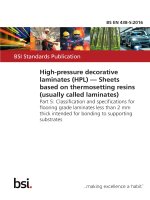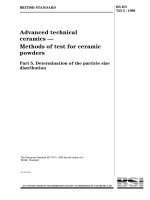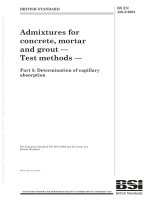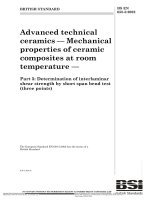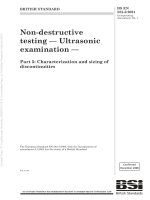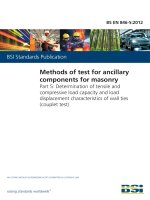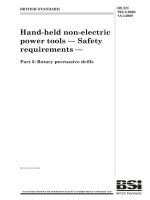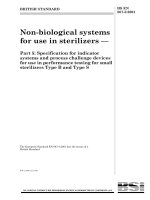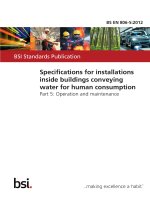Bsi bs en 61158 5 13 2014
Bạn đang xem bản rút gọn của tài liệu. Xem và tải ngay bản đầy đủ của tài liệu tại đây (1.96 MB, 64 trang )
BS EN 61158-5-13:2014
BSI Standards Publication
Industrial communication
networks — Fieldbus
specifications
Part 5-13: Application layer service
definition — Type 13 elements
BRITISH STANDARD
BS EN 61158-5-13:2014
National foreword
This British Standard is the UK implementation of EN 61158-5-13:2014. It is
identical to IEC 61158-5-13:2014. It supersedes BS EN 61158-5-13:2008
which is withdrawn.
The UK participation in its preparation was entrusted to Technical Committee AMT/7, Industrial communications: process measurement and
control, including fieldbus.
A list of organizations represented on this committee can be obtained on
request to its secretary.
This publication does not purport to include all the necessary provisions of
a contract. Users are responsible for its correct application.
© The British Standards Institution 2014.
Published by BSI Standards Limited 2014
ISBN 978 0 580 79459 9
ICS 25.040.40; 35.100.70
Compliance with a British Standard cannot confer immunity from
legal obligations.
This British Standard was published under the authority of the
Standards Policy and Strategy Committee on 31 October 2014.
Amendments/corrigenda issued since publication
Date
Text affected
BS EN 61158-5-13:2014
EUROPEAN STANDARD
EN 61158-5-13
NORME EUROPÉENNE
EUROPÄISCHE NORM
October 2014
ICS 25.040.40; 35.100.70; 35.110
Supersedes EN 61158-5-13:2008
English Version
Industrial communication networks - Fieldbus specifications Part 5-13: Application layer service definition - Type 13 elements
(IEC 61158-5-13:2014)
Réseaux de communication industriels - Spécifications des
bus de terrain - Partie 5-13: Définition des services de la
couche application - Éléments de type 13
(CEI 61158-5-13:2014)
Industrielle Kommunikationsnetze - Feldbusse Teil 5-13: Dienstfestlegungen des Application Layer
(Anwendungsschicht) - Typ 13-Elemente
(IEC 61158-5-13:2014)
This European Standard was approved by CENELEC on 2014-09-22. CENELEC members are bound to comply with the CEN/CENELEC
Internal Regulations which stipulate the conditions for giving this European Standard the status of a national standard without any alteration.
Up-to-date lists and bibliographical references concerning such national standards may be obtained on application to the CEN-CENELEC
Management Centre or to any CENELEC member.
This European Standard exists in three official versions (English, French, German). A version in any other language made by translation
under the responsibility of a CENELEC member into its own language and notified to the CEN-CENELEC Management Centre has the
same status as the official versions.
CENELEC members are the national electrotechnical committees of Austria, Belgium, Bulgaria, Croatia, Cyprus, the Czech Republic,
Denmark, Estonia, Finland, Former Yugoslav Republic of Macedonia, France, Germany, Greece, Hungary, Iceland, Ireland, Italy, Latvia,
Lithuania, Luxembourg, Malta, the Netherlands, Norway, Poland, Portugal, Romania, Slovakia, Slovenia, Spain, Sweden, Switzerland,
Turkey and the United Kingdom.
European Committee for Electrotechnical Standardization
Comité Européen de Normalisation Electrotechnique
Europäisches Komitee für Elektrotechnische Normung
CEN-CENELEC Management Centre: Avenue Marnix 17, B-1000 Brussels
© 2014 CENELEC All rights of exploitation in any form and by any means reserved worldwide for CENELEC Members.
Ref. No. EN 61158-5-13:2014 E
BS EN 61158-5-13:2014
EN 61158-5-13:2014
-2-
Foreword
The text of document 65C/763/FDIS, future edition 2 of IEC 61158-5-13, prepared by
SC 65C “Industrial networks” of IEC/TC 65 “Industrial-process measurement, control and automation"
was submitted to the IEC-CENELEC parallel vote and approved by CENELEC as
EN 61158-5-13:2014.
The following dates are fixed:
•
latest date by which the document has to be
implemented at national level by
publication of an identical national
standard or by endorsement
(dop)
2015-06-22
•
latest date by which the national
standards conflicting with the
document have to be withdrawn
(dow)
2017-09-22
This document supersedes EN 61158-5-13:2008.
Attention is drawn to the possibility that some of the elements of this document may be the subject of
patent rights. CENELEC [and/or CEN] shall not be held responsible for identifying any or all such
patent rights.
This document has been prepared under a mandate given to CENELEC by the European Commission
and the European Free Trade Association.
Endorsement notice
The text of the International Standard IEC 61158-5-13:2014 was approved by CENELEC as a
European Standard without any modification.
In the official version, for Bibliography, the following notes have to be added for the standards indicated:
IEC 61784-1
NOTE
Harmonized as EN 61784-1.
IEC 61784-2
NOTE
Harmonized as EN 61784-2.
BS EN 61158-5-13:2014
EN 61158-5-13:2014
-3-
Annex ZA
(normative)
Normative references to international publications
with their corresponding European publications
The following documents, in whole or in part, are normatively referenced in this document and are
indispensable for its application. For dated references, only the edition cited applies. For undated
references, the latest edition of the referenced document (including any amendments) applies.
NOTE 1 When an International Publication has been modified by common modifications, indicated by (mod), the relevant
EN/HD applies.
NOTE 2 Up-to-date information on the latest versions of the European Standards listed in this annex is available here:
www.cenelec.eu
Publication
Year
Title
EN/HD
Year
IEC 61158-1
2014
Industrial communication networks Fieldbus specifications Part 1: Overview and guidance for the
IEC 61158 and IEC 61784 series
EN 61158-1
2014
IEC 61158-3-13
-
Industrial communication networks EN 61158-3-13
Fieldbus specifications Part 3-13: Data-link layer service definition
- Type 13 elements
-
IEC 61158-4-13
-
Industrial communication networks Fieldbus specifications Part 4-13: Data-link layer protocol
specification - Type 13 elements
EN 61158-4-13
-
IEC 61158-6
Series
Industrial communication networks Fieldbus specifications Part 6: Application layer protocol
specification
EN 61158-6
Series
IEC 61158-6-13
-
Industrial communication networks Fieldbus specifications Part 6-13: Application layer protocol
specification - Type 13 elements
EN 61158-6-13
-
ISO/IEC 646
-
Information technology - ISO 7-bit coded
character set for information interchange
-
-
ISO/IEC 7498-1
-
Information technology - Open Systems
Interconnection - Basic reference model:
The basic model
-
-
ISO/IEC 8822
-
Information technology - Open Systems
Interconnection - Presentation service
definition
-
-
ISO/IEC 9545
-
Information technology - Open Systems
Interconnection - Application layer
structure
-
-
ISO/IEC 10731
-
Information technology - Open Systems
Interconnection - Basic Reference Model Conventions for the definition of OSI
services
-
IEEE 754
-
IEEE Standard for Floating-Point
Arithmetic
-
-
–2–
BS EN 61158-5-13:2014
IEC 61158-5-13:2014 © IEC 2014
CONTENTS
INTRODUCTION ..................................................................................................................... 6
1
Scope ............................................................................................................................... 7
2
1.1 General ................................................................................................................... 7
1.2 Specifications .......................................................................................................... 8
1.3 Conformance ........................................................................................................... 8
Normative references ....................................................................................................... 8
3
Terms, definitions, symbols, abbreviations and conventions ............................................. 9
4
3.1 ISO/IEC 7498-1 terms ........................................................................................... 10
3.2 ISO/IEC 8822 terms .............................................................................................. 10
3.3 ISO/IEC 9545 terms .............................................................................................. 10
3.4 Fieldbus application-layer specific definitions ........................................................ 10
3.5 Abbreviations and symbols .................................................................................... 17
3.6 Conventions .......................................................................................................... 18
Concepts ........................................................................................................................ 20
5
4.1 Common concepts ................................................................................................. 20
4.2 Type specific concepts .......................................................................................... 21
Data type ASE ................................................................................................................ 22
6
5.1
5.2
5.3
5.4
Type
General ................................................................................................................. 22
Formal definition of data type objects .................................................................... 22
FAL defined data types .......................................................................................... 22
Data type ASE service specification ...................................................................... 28
13 communication model specification ................................................................... 28
6.1 ASEs ..................................................................................................................... 28
6.2 ARs ....................................................................................................................... 50
6.3 Summary of FAL classes ....................................................................................... 57
6.4 Permitted FAL services by AREP role .................................................................... 58
Bibliography .......................................................................................................................... 59
Figure 1 – The ASEs of Type 13 ........................................................................................... 22
Figure 2 – The AR ASE conveys APDUs between APs ......................................................... 46
Table 1 – Overall structure of the OD .................................................................................... 21
Table 2 – Ident service ......................................................................................................... 31
Table 3 – Status service ....................................................................................................... 32
Table 4 – Sync service .......................................................................................................... 33
Table 5 – NMT-req-invite service .......................................................................................... 34
Table 6 – NMT-state-command service ................................................................................. 35
Table 7 – NMT-info service ................................................................................................... 36
Table 8 – SDO-write ............................................................................................................. 38
Table 9 – SDO-write-mult ...................................................................................................... 39
Table 10 – SDO-read ............................................................................................................ 41
Table 11 – SDO-read-mult .................................................................................................... 42
Table 12 – SDO-abort ........................................................................................................... 43
BS EN 61158-5-13:2014
IEC 61158-5-13:2014 © IEC 2014
–3–
Table 13 – PDO-transfer ....................................................................................................... 45
Table 14 – Conveyance of service primitives by AREP role ................................................... 47
Table 15 – Valid combinations of AREP roles involved in an AR ........................................... 47
Table 16 – FAL class summary ............................................................................................. 57
Table 17 – Services by AREP role ........................................................................................ 58
–6–
BS EN 61158-5-13:2014
IEC 61158-5-13:2014 © IEC 2014
INTRODUCTION
This part of IEC 61158 is one of a series produced to facilitate the interconnection of
automation system components. It is related to other standards in the set as defined by the
“three-layer” fieldbus reference model described in IEC 61158-1.
The application service is provided by the application protocol making use of the services
available from the data-link or other immediately lower layer. This standard defines the
application service characteristics that fieldbus applications and/or system management may
exploit.
Throughout the set of fieldbus standards, the term “service” refers to the abstract capability
provided by one layer of the OSI Basic Reference Model to the layer immediately above.
Thus, the application layer service defined in this standard is a conceptual architectural
service, independent of administrative and implementation divisions.
BS EN 61158-5-13:2014
IEC 61158-5-13:2014 © IEC 2014
–7–
INDUSTRIAL COMMUNICATION NETWORKS –
FIELDBUS SPECIFICATIONS –
Part 5-13: Application layer service definition –
Type 13 elements
1
1.1
Scope
General
The fieldbus Application Layer (FAL) provides user programs with a means to access the
fieldbus communication environment. In this respect, the FAL can be viewed as a “window
between corresponding application programs.”
This standard provides common elements for basic time-critical and non-time-critical
messaging communications between application programs in an automation environment and
material specific to Type 13 fieldbus. The term “time-critical” is used to represent the
presence of a time-window, within which one or more specified actions are required to be
completed with some defined level of certainty. Failure to complete specified actions within
the time window risks failure of the applications requesting the actions, with attendant risk to
equipment, plant and possibly human life.
This standard defines in an abstract way the externally visible service provided by the
different Types of the fieldbus Application Layer in terms of
a) an abstract model for defining application resources (objects) capable of being
manipulated by users via the use of the FAL service,
b) the primitive actions and events of the service;
c) the parameters associated with each primitive action and event, and the form which they
take; and
d) the interrelationship between these actions and events, and their valid sequences.
The purpose of this standard is to define the services provided to
1) the FAL user at the boundary between the user and the Application Layer of the Fieldbus
Reference Model, and
2) Systems Management at the boundary between the Application Layer and Systems
Management of the Fieldbus Reference Model.
This standard specifies the structure and services of the IEC fieldbus Application Layer, in
conformance with the OSI Basic Reference Model (ISO/IEC 7498-1) and the OSI Application
Layer Structure (ISO/IEC 9545).
FAL services and protocols are provided by FAL application-entities (AE) contained within the
application processes. The FAL AE is composed of a set of object-oriented Application
Service Elements (ASEs) and a Layer Management Entity (LME) that manages the AE. The
ASEs provide communication services that operate on a set of related application process
object (APO) classes. One of the FAL ASEs is a management ASE that provides a common
set of services for the management of the instances of FAL classes.
Although these services specify, from the perspective of applications, how request and
responses are issued and delivered, they do not include a specification of what the requesting
and responding applications are to do with them. That is, the behavioral aspects of the
applications are not specified; only a definition of what requests and responses they can
–8–
BS EN 61158-5-13:2014
IEC 61158-5-13:2014 © IEC 2014
send/receive is specified. This permits greater flexibility to the FAL users in standardizing
such object behavior. In addition to these services, some supporting services are also defined
in this standard to provide access to the FAL to control certain aspects of its operation.
1.2
Specifications
The principal objective of this standard is to specify the characteristics of conceptual
application layer services suitable for time-critical communications, and thus supplement the
OSI Basic Reference Model in guiding the development of application layer protocols for timecritical communications.
A secondary objective is to provide migration paths from previously-existing industrial
communications protocols. It is this latter objective which gives rise to the diversity of services
standardized as the various Types of IEC 61158, and the corresponding protocols
standardized in subparts of IEC 61158-6.
This specification may be used as the basis for formal Application Programming-Interfaces.
Nevertheless, it is not a formal programming interface, and any such interface will need to
address implementation issues not covered by this specification, including
a) the sizes and octet ordering of various multi-octet service parameters, and
b) the correlation of paired request and confirm, or indication and response, primitives.
1.3
Conformance
This standard does not specify individual implementations or products, nor does it constrain
the implementations of application layer entities within industrial automation systems.
There is no conformance of equipment to this application layer service definition standard.
Instead, conformance is achieved through implementation of conforming application layer
protocols that fulfill any given Type of application layer services as defined in this standard.
2
Normative references
The following documents, in whole or in part, are normatively referenced in this document and
are indispensable for its application. For dated references, only the edition cited applies. For
undated references, the latest edition of the referenced document (including any
amendments) applies.
NOTE All parts of the IEC 61158 series, as well as IEC 61784-1 and IEC 61784-2 are maintained simultaneously.
Cross-references to these documents within the text therefore refer to the editions as dated in this list of normative
references.
IEC 61158-1:2014, Industrial communication networks – Fieldbus specifications – Part 1:
Overview and guidance for the IEC 61158 and IEC 61784 series
IEC 61158-3-13, Industrial communication networks – Fieldbus specifications – Part 3-13:
Data-link layer service definition – Type 13 elements
IEC 61158-4-13, Industrial communication networks – Fieldbus specifications – Part 4-13:
Data-link layer protocol specification – Type 13 elements
IEC 61158-6 (all parts), Industrial communication networks – Fieldbus specifications – Part 6:
Application layer protocol specification
IEC 61158-6-13, Industrial communication networks – Fieldbus specifications – Part 6-13:
Application layer protocol specification – Type 13 elements
BS EN 61158-5-13:2014
IEC 61158-5-13:2014 © IEC 2014
–9–
ISO/IEC 646, Information technology – ISO 7-bit coded character set for information
interchange
ISO/IEC 7498-1, Information technology – Open Systems Interconnection – Basic Reference
Model – Part 1: The Basic Model
ISO/IEC 8822, Information technology – Open Systems Interconnection – Presentation
service definition
ISO/IEC 9545, Information technology – Open Systems Interconnection – Application Layer
structure
ISO/IEC 10731, Information technology – Open Systems Interconnection – Basic Reference
Model – Conventions for the definition of OSI services
IEEE 754, IEEE Standard for Floating-Point Arithmetic
3
Terms, definitions, symbols, abbreviations and conventions
For the purposes of this document, the following terms, definitions, symbols, abbreviations
and conventions apply
– 10 –
3.1
BS EN 61158-5-13:2014
IEC 61158-5-13:2014 © IEC 2014
ISO/IEC 7498-1 terms
3.1.1 application entity
3.1.2 application process
3.1.3 application protocol data unit
3.1.4 application service element
3.1.5 application entity invocation
3.1.6 application process invocation
3.1.7 application transaction
3.1.8 real open system
3.1.9 transfer syntax
3.2
ISO/IEC 8822 terms
3.2.1 abstract syntax
3.2.2 presentation context
3.3
ISO/IEC 9545 terms
3.3.1 application-association
3.3.2 application-context
3.3.3 application context name
3.3.4 application-entity-invocation
3.3.5 application-entity-type
3.3.6 application-process-invocation
3.3.7 application-process-type
3.3.8 application-service-element
3.3.9 application control service element
3.4
Fieldbus application-layer specific definitions
For the purposes of this part of IEC 61158, the following terms and definitions apply.
3.4.1
application
function or data structure for which data is consumed or produced
3.4.2
application objects
multiple object classes that manage and provide a run time exchange of messages across the
network and within the network device
3.4.3
application process
part of a distributed application on a network, which is located on one device and
unambiguously addressed
3.4.4
application process identifier
distinguishes multiple application processes used in a device
BS EN 61158-5-13:2014
IEC 61158-5-13:2014 © IEC 2014
– 11 –
3.4.5
application process object
component of an application process that is identifiable and accessible through an FAL
application relationship
Note 1 to entry: Application process object definitions are composed of a set of values for the attributes of their
class (see the definition for Application Process Object Class Definition). Application process object definitions
may be accessed remotely using the services of the FAL Object Management ASE. FAL Object Management
services can be used to load or update object definitions, to read object definitions, and to dynamically create and
delete application objects and their corresponding definitions.
3.4.6
application process object class
class of application process objects defined in terms of the set of their network-accessible
attributes and services
3.4.7
application relationship
cooperative association between two or more application-entity-invocations for the purpose of
exchange of information and coordination of their joint operation
Note 1 to entry: This relationship is activated either by the exchange of application-protocol-data-units or as a
result of preconfiguration activities.
3.4.8
application relationship application service element
application-service-element that provides the exclusive
terminating all application relationships
means
for
establishing
and
3.4.9
application relationship endpoint
context and behavior of an application relationship as seen and maintained by one of the
application processes involved in the application relationship
Note 1 to entry: Each application process involved in the application relationship maintains its own application
relationship endpoint.
3.4.10
attribute
description of an externally visible characteristic or feature of an object
Note 1 to entry: The attributes of an object contain information about variable portions of an object. Typically,
they provide status information or govern the operation of an object. Attributes may also affect the behavior of an
object. Attributes are divided into class attributes and instance attributes.
3.4.11
behavior
indication of how an object responds to particular events
3.4.12
channel
single physical or logical link of an input or output application object of a server to the process
3.4.13
class
set of objects, all of which represent the same kind of system component
Note 1 to entry: A class is a generalisation of an object; a template for defining variables and methods. All objects
in a class are identical in form and behavior, but usually contain different data in their attributes.
– 12 –
BS EN 61158-5-13:2014
IEC 61158-5-13:2014 © IEC 2014
3.4.14
class attributes
attribute that is shared by all objects within the same class
3.4.15
class code
unique identifier assigned to each object class
3.4.16
class specific service
service defined by a particular object class to perform a required function which is not
performed by a common service
Note 1 to entry:
A class specific object is unique to the object class which defines it.
3.4.17
client
a) object which uses the services of another (server) object to perform a task
b) initiator of a message to which a server reacts
3.4.18
controlled node
All nodes except one (this is the Managing Node) in a Type 13 network are of this type
3.4.19
connection
logical binding between application objects that may be within the same or different devices
Note 1 to entry: Connections may be either point-to-point or multipoint.
3.4.20
connection channel
description of a connection between a sink and a source of data items
3.4.21
connection path
an octet stream that defines the application object to which a connection instance applies
3.4.22
connection point
buffer which is represented as a subinstance of an Assembly object
3.4.23
consume
act of receiving data from a producer
3.4.24
consumer
node or sink that is receiving data from a producer
3.4.25
consuming application
application that consumes data
3.4.26
control commands
action invocations transferred from client to server to clear outputs, freeze inputs and/or
synchronise outputs
BS EN 61158-5-13:2014
IEC 61158-5-13:2014 © IEC 2014
– 13 –
3.4.27
conveyance path
unidirectional flow of APDUs across an application relationship
3.4.28
cyclic
repetitive in a regular manner
3.4.29
data consistency
means for coherent transmission and access of the input- or output-data object between and
within client and server
3.4.30
device
physical hardware connected to the link
Note 1 to entry:
A device may contain more than one node.
3.4.31
device profile
a collection of device dependent information and functionality providing consistency between
similar devices of the same device type
3.4.32
diagnosis information
all data available at the server for maintenance purposes
3.4.33
end node
producing or consuming node
3.4.34
endpoint
one of the communicating entities involved in a connection
3.4.35
error
discrepancy between a computed, observed or measured value or condition and the specified
or theoretically correct value or condition
3.4.36
error class
general grouping for related error definitions and corresponding error codes
3.4.37
error code
identification of a specific type of error within an error class
3.4.38
event
an instance of a change of conditions
3.4.39
FIFO variable
a Variable Object class, composed of a set of homogeneously typed elements, where the first
written element is the first element that can be read
– 14 –
Note 1 to entry:
invocation.
BS EN 61158-5-13:2014
IEC 61158-5-13:2014 © IEC 2014
On the fieldbus only one, complete element can be transferred as a result of one service
3.4.40
frame
denigrated synonym for DLPDU
3.4.41
group
a) <general> general term for a collection of objects
Specific uses:
b) <addressing> when describing an address, an address that identifies more than one entity
3.4.42
invocation
act of using a service or other resource of an application process
Note 1 to entry: Each invocation represents a separate thread of control that may be described by its context.
Once the service completes, or use of the resource is released, the invocation ceases to exist. For service
invocations, a service that has been initiated but not yet completed is referred to as an outstanding service
invocation. Also for service invocations, an Invoke ID may be used to unambiguously identify the service invocation
and differentiate it from other outstanding service invocations.
3.4.43
index
address of an object within an application process
3.4.44
instance
the actual physical occurrence of an object within a class that identifies one of many objects
within the same object class
EXAMPLE California is an instance of the object class US-state.
Note 1 to entry:
The terms object, instance, and object instance are used to refer to a specific instance.
3.4.45
instance attributes
attribute that is unique to an object instance and not shared by the object class
3.4.46
instantiated
object that has been created in a device
3.4.47
logical device
a certain FAL class that abstracts a software component or a firmware component as an
autonomous self-contained facility of an automation device
3.4.48
manufacturer ID
identification of each product manufacturer by a unique number
3.4.49
management information
network-accessible information that supports managing the operation of the fieldbus system,
including the application layer
Note 1 to entry:
Managing includes functions such as controlling, monitoring, and diagnosing.
BS EN 61158-5-13:2014
IEC 61158-5-13:2014 © IEC 2014
– 15 –
3.4.50
message router
object within a node that distributes messaging requests to appropriate application objects
3.4.51
managing node
One node of a type 13 network must act as a managing node.
3.4.52
multi-point connection
connection from one node to many
Note 1 to entry:
nodes.
Multipoint connections allow messages from a single producer to be received by many consumer
3.4.53
network
a set of nodes connected by some type of communication medium, including any intervening
repeaters, bridges, routers and lower-layer gateways
3.4.54
node
host of one AP, identified by a unique DLCEP-address
3.4.55
object
abstract representation of a particular component within a device, usually a collection of
related data (in the form of variables) and methods (procedures) for operating on that data
that have clearly defined interface and behavior
3.4.56
object dictionary
Collection of definitions. communication specific attributes and parameters, and application
dependent data
3.4.57
object specific service
service unique to the object class which defines it
3.4.58
originator
client responsible for establishing a connection path to the target
3.4.59
physical device
automation or other network device
3.4.60
point-to-point connection
connection that exists between exactly two application objects
3.4.61
pre-established AR endpoint
AR endpoint that is placed in an established state during configuration of the AEs that control
its endpoints
– 16 –
BS EN 61158-5-13:2014
IEC 61158-5-13:2014 © IEC 2014
3.4.62
process data
object(s) which are already pre-processed and transferred cyclically for the purpose of
information or further processing
3.4.63
produce
act of sending data to be received by a consumer
3.4.64
producer
node that is responsible for sending data
3.4.65
property
general term for descriptive information about an object
3.4.66
provider
source of a data connection
3.4.67
publisher
role of an AR endpoint that transmits APDUs onto the fieldbus for consumption by one or
more subscribers
Note 1 to entry:
A publisher may not be aware of the identity or the number of subscribers.
3.4.68
publishing manager
role of an AR endpoint in which it issues one or more confirmed service request APDUs to a
publisher to request the publisher to publish a specified object
Note 1 to entry: Two types of publishing managers are defined by this standard, pull publishing managers and
push publishing managers, each of which is defined separately.
3.4.69
push publisher
type of publisher that publishes an object in an unconfirmed service request APDU
3.4.70
push publishing manager
type of publishing manager that requests that a specified object be published using an
unconfirmed service
3.4.71
push subscriber
type of subscriber that recognizes received unconfirmed service request APDUs as published
object data
3.4.72
server
a) role of an AREP in which it returns a confirmed service response APDU to the client that
initiated the request
b) object which provides services to another (client) object
3.4.73
service
operation or function than an object and/or object class performs upon request from another
object and/or object class
BS EN 61158-5-13:2014
IEC 61158-5-13:2014 © IEC 2014
– 17 –
3.4.74
subscriber
role of an AREP in which it receives APDUs produced by a publisher
3.4.75
target
end-node to which a connection is established
3.5
Abbreviations and symbols
AE
Application entity
AL
Application layer
ALME
Application layer management entity
ALP
Application layer protocol
APO
Application object
AP
Application process
APDU
Application protocol data unit
AR
Application relationship
AREP
Application relationship end point
ASCII
American Standard Code for Information Interchange
ASE
Application service element
BNB-PEC
Buffered network-scheduled bi-directional pre-established connection
BNU-PEC
Buffered network-scheduled uni-directional pre-established connection
CID
Connection ID
CN
Controlled node
Cnf
Confirmation
DL-
(as a prefix) data-link-
DLCEP
Data-link connection end point
DLL
Data-link layer
DLM
Data-link-management
DLSAP
Data-link service access point
DLSDU
DL-service-data-unit
DNS
Domain name service
FAL
Fieldbus application layer
Ind
Indication
IP
Internet protocol (see RFC 791)
MN
Managing node
NMT
Network management
OD
Object dictionary
PDO
Process data object
PReq
PollRequest (Type 13 frame type)
PRes
PollRespons (Type 13 frame type)
QUB-CL
Queued user-triggered bi-directional connectionless
QUB-COS
Queued
user-triggered
segmentation
QUU
Queued user-triggered uni-directional
bi-directional
connection-oriented
with
– 18 –
Req
Request
RPDO
Receive process data object
Rsp
Response
SDO
Service data object
TPDO
Transmit process data object
3.6
3.6.1
BS EN 61158-5-13:2014
IEC 61158-5-13:2014 © IEC 2014
Conventions
Overview
The FAL is defined as a set of object-oriented ASEs. Each ASE is specified in a separate
subclause. Each ASE specification is composed of two parts, its class specification, and its
service specification.
The class specification defines the attributes of the class. The access to these attributes is
beyond the scope of this document except where specified. The service specification defines
the services that are provided by the ASE.
3.6.2
General conventions
This standard uses the descriptive conventions given in ISO/IEC 10731.
3.6.3
Conventions for class definitions
Class definitions are described using templates. Each template consists of a list of attributes
for the class. The general form of the template is shown below:
FAL ASE:
CLASS:
CLASS ID:
PARENT CLASS:
ATTRIBUTES:
ASE name
Class name
#
Parent class name
1
(o)
2
(o)
3
(m)
4
(m)
4.1
(s)
4.2
(s)
4.3
(s)
5.
(c)
5.1
(m)
5.2
(o)
6
(m)
6.1
(s)
6.2
(s)
SERVICES:
Key Attribute:
Key Attribute:
Attribute:
Attribute:
Attribute:
Attribute:
Attribute:
Constraint:
Attribute:
Attribute:
Attribute:
Attribute:
Attribute:
numeric identifier
name
attribute name(values)
attribute name(values)
attribute name(values)
attribute name(values)
attribute name(values)
constraint expression
attribute name(values)
attribute name(values)
attribute name(values)
attribute name(values)
attribute name(values)
1
2
2.1
3
OpsService:
Constraint:
OpsService:
MgtService:
service name
constraint expression
service name
service name
(o)
(c)
(o)
(m)
(1) The "FAL ASE:" entry is the name of the FAL ASE that provides the services for the class
being specified.
BS EN 61158-5-13:2014
IEC 61158-5-13:2014 © IEC 2014
– 19 –
(2) The "CLASS:" entry is the name of the class being specified. All objects defined using this
template will be an instance of this class. The class may be specified by this standard, or
by a user of this standard.
(3) The "CLASS ID:" entry is a number that identifies the class being specified. This number is
not used for Type 13 elements.
(4) The "PARENT CLASS:" entry is the name of the parent class for the class being specified.
All attributes defined for the parent class and inherited by it are inherited for the class
being defined, and therefore do not have to be redefined in the template for this class.
NOTE The parent-class "TOP" indicates that the class being defined is an initial class definition. The parent class
TOP is used as a starting point from which all other classes are defined. The use of TOP is reserved for classes
defined by this standard.
(5) The "ATTRIBUTES" label indicate that the following entries are attributes defined for the
class.
a) Each of the attribute entries contains a line number in column 1, a mandatory (m) /
optional (o) / conditional (c) / selector (s) indicator in column 2, an attribute type label
in column 3, a name or a conditional expression in column 4, and optionally a list of
enumerated values in column 5. In the column following the list of values, the default
value for the attribute may be specified.
b) Objects are normally identified by a numeric identifier or by an object name, or by
both. In the class templates, these key attributes are defined under the key attribute.
c) The line number defines the sequence and the level of nesting of the line. Each
nesting level is identified by period. Nesting is used to specify
i)
fields of a structured attribute (4.1, 4.2, 4.3),
ii) attributes conditional on a constraint statement (5). Attributes may be mandatory
(5.1) or optional (5.2) if the constraint is true. Not all optional attributes require
constraint statements as does the attribute defined in (5.2).
iii) the selection fields of a choice type attribute (6.1 and 6.2).
(6) The "SERVICES" label indicates that the following entries are services defined for the
class.
a) An (m) in column 2 indicates that the service is mandatory for the class, while an (o)
indicates that it is optional. A (c) in this column indicates that the service is conditional.
When all services defined for a class are defined as optional, at least one has to be
selected when an instance of the class is defined.
b) The label "OpsService" designates an operational service (1).
c) The label "MgtService" designates a management service (2).
d) The line number defines the sequence and the level of nesting of the line. Each
nesting level is identified by period. Nesting within the list of services is used to specify
services conditional on a constraint statement.
3.6.4
3.6.4.1
Conventions for service definitions
General
The service model, service primitives, and time-sequence diagrams used are entirely abstract
descriptions; they do not represent a specification for implementation.
3.6.4.2
Service parameters
Service primitives are used to represent service user/service provider interactions
(ISO/IEC 10731). They convey parameters which indicate information available in the
user/provider interaction. In any particular interface, not all parameters need be explicitly
stated.
– 20 –
BS EN 61158-5-13:2014
IEC 61158-5-13:2014 © IEC 2014
The service specifications of this standard use a tabular format to describe the component
parameters of the ASE service primitives. The parameters which apply to each group of
service primitives are set out in tables. Each table consists of up to five columns for the
1) parameter name,
2) request primitive,
3) indication primitive,
4) response primitive, and
5) confirm primitive.
One parameter (or component of it) is listed in each row of each table. Under the appropriate
service primitive columns, a code is used to specify the type of usage of the parameter on the
primitive specified in the column:
M parameter is mandatory for the primitive
U parameter is a User option, and may or may not be provided depending on dynamic
usage of the service user. When not provided, a default value for the parameter is
assumed.
C parameter is conditional upon other parameters or upon the environment of the service
user.
— (blank) parameter is never present.
S
parameter is a selected item.
Some entries are further qualified by items in brackets. These may be
a) a parameter-specific constraint:
“(=)” indicates that the parameter is semantically equivalent to the parameter in the
service primitive to its immediate left in the table.
b) an indication that some note applies to the entry:
“(n)” indicates that the following note "n" contains additional information pertaining to
the parameter and its use.
Service procedures
The procedures are defined in terms of
•
the interactions between application entities through the exchange of fieldbus Application
Protocol Data Units, and
•
the interactions between an application layer service provider and an application layer
service user in the same system through the invocation of application layer service
primitives.
These procedures are applicable to instances of communication between systems which
support time-constrained communications services within the fieldbus application layer.
4
4.1
Concepts
Common concepts
IEC 61158-1, Clause 9 is incorporated by reference, except as specifically overridden in 4.2.
BS EN 61158-5-13:2014
IEC 61158-5-13:2014 © IEC 2014
4.2
– 21 –
Type specific concepts
4.2.1
Managing Node and Controlled Nodes
The node managing the permission to send messages to the Ethernet is called the Managing
Node (MN). Only the MN may send messages independently – i.e. not as a response to a
received message. All available nodes in the network are configured on the MN. Only one
active MN is permitted in the network.
All other nodes transmit only within communication slots assigned by the MN. They are thus
called Controlled Nodes (CN). CNs are passive bus nodes which only send when requested
by the MN. There are two types of CNs:
•
Isochronous CNs are able to communicate both via network-scheduled and user-triggered
ARs.
•
Async-only CNs communicate only via user-triggered ARs.
The sequence and the assignment of time slots for network-scheduled and user-triggered
interactions is specified in IEC 61158-3-13 and IEC 61158-4-13.
4.2.2
Node, AP, and Object dictionary
Each node hosts exactly one AP. All APOs for this AP are collected in the so called Object
dictionary (OD). The overall structure of the OD is as described in Table 1.
Table 1 – Overall structure of the OD
Area
4.2.3
Contents
Data type area
Definition of the data types
Communication profile area
Contains the communication specific parameters for the
Type 13 network. These entries are common to all devices
Manufacturer specific area
Definition of manufacturer specific variables
Device profile area
Definition of the variables defined in a device profile (not in
the scope of this standard)
Reserved area
Reserved for future use
Object management ASE
There is no object management ASE defined for Type 13.
4.2.4
Timeliness
The "timeliness" feature is not implemented in the Type 13 FAL. The monitoring and control of
the cycle timing is managed by the DLL, see IEC 61158-3-13 and IEC 61158-4-13.
4.2.5
APO ASEs
The FAL ASEs of Type 13 and their interrelationships are described in Figure 1.
– 22 –
BS EN 61158-5-13:2014
IEC 61158-5-13:2014 © IEC 2014
FAL AP
ASE requests and responses
SDO
ASE
AP
ASE
PDO
ASE
APO ASEs
AR ASE
service
primitives
AR
ASE
Conveyance of APDUs by the AR ASE
Figure 1 – The ASEs of Type 13
5
Data type ASE
5.1
General
IEC 61158-1, 10.1 is incorporated by reference with one restriction: Only nesting level of 1
(see IEC 61158-1, 10.1.4.4) is supported.
5.2
Formal definition of data type objects
IEC 61158-1, 10.2 is incorporated by reference.
5.3
FAL defined data types
5.3.1
5.3.1.1
Fixed length types
Boolean types
CLASS:
ATTRIBUTES:
Data type
1
2
3
3.1
=
=
=
=
Data type numeric identifier
Data type name
Format
Octet length
1
Boolean
FIXED LENGTH
1
This data type expresses a Boolean data type with the values TRUE and FALSE.
BS EN 61158-5-13:2014
IEC 61158-5-13:2014 © IEC 2014
5.3.1.2
– 23 –
Date/Time types
5.3.1.2.1
TimeOfDay
CLASS:
ATTRIBUTES:
Data type
1
2
3
3.1
=
=
=
=
Data type numeric identifier
Data type name
Format
Octet length
12
TimeOfDay
FIXED LENGTH
6
This data type is composed of two elements of unsigned values and expresses the time of day
and the date. The first element is an Unsigned32 data type and gives the time after the
midnight in milliseconds. The second element is an Unsigned16 data type and gives the date
counting the days from January 1, 1984.
5.3.1.2.2
TimeDifference
CLASS:
ATTRIBUTES:
Data type
1
2
3
3.1
=
=
=
=
Data type numeric identifier
Data type name
Format
Octet length
13
TimeDifference
FIXED LENGTH
4 or 6
This data type is composed of two elements of unsigned values that express the difference in
time. The first element is an Unsigned32 data type that provides the fractional portion of one
day in milliseconds. The optional second element is an Unsigned16 data type that provides
the difference in days.
5.3.1.3
Numeric types
5.3.1.3.1
Real32
CLASS:
ATTRIBUTES:
Data type
1
2
3
3.1
=
=
=
=
Data type numeric identifier
Data type name
Format
Octet length
8
Real32
FIXED LENGTH
4
This type has a length of four octets. The format for Real32 is that defined by IEEE 754 as
single precision.
5.3.1.3.2
Real64
CLASS:
ATTRIBUTES:
Data type
1
2
3
3.1
=
=
=
=
Data type numeric identifier
Data type name
Format
Octet length
17
Real64
FIXED LENGTH
8
This type has a length of eight octets. The format for Real64 is that defined by IEEE 754 as
double precision.
